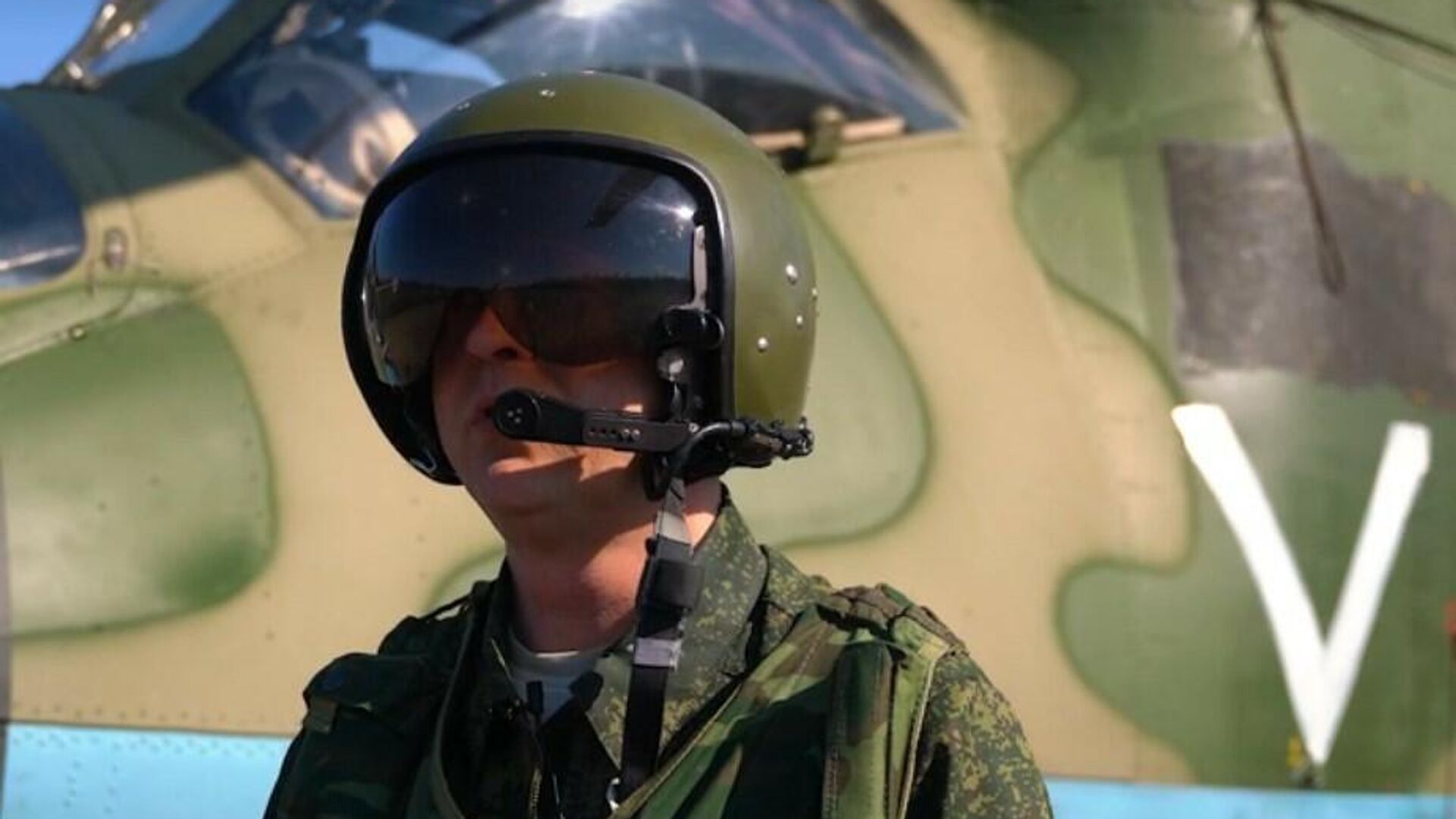https://sputnikglobe.com/20220321/i-knew-i-had-to-survive-somehow-russian-helicopter-pilot-reveals-how-he-dodged-ukrainian-stinger-1094052566.html
'I Knew I Had to Survive Somehow': Russian Helicopter Pilot Reveals How He Dodged Ukrainian Stinger
'I Knew I Had to Survive Somehow': Russian Helicopter Pilot Reveals How He Dodged Ukrainian Stinger
Sputnik International
Commenting on Moscow's special operation that is now under way in Ukraine, President Vladimir Putin stressed last week that Russian soldiers and officers fight... 21.03.2022, Sputnik International
2022-03-21T12:34+0000
2022-03-21T12:34+0000
2022-03-21T12:34+0000
russia's special operation in ukraine
russia
ukraine
special operation
mi-24
helicopter
stinger missiles
https://cdn1.img.sputnikglobe.com/img/07e6/03/15/1094050145_0:14:925:534_1920x0_80_0_0_78c5ac8c719778b31b62fbc487ae25d4.jpg
During a mission conducted as part of Moscow's ongoing special military operation in Ukraine, the crew of a Russian Mi-24 attack helicopter managed to evade a rocket fired by Ukrainian troops from a portable missile system, the Russian Defence Ministry has revealed.In an interview released by the ministry on Monday, Mi-24 commander Oleg Esman explained that the incident took place as a group of Russian combat helicopters cleared a Ukrainian airfield to ensure the landing of Russian paratroopers from Mi-8 transport choppers.Referring to his Mi-24 helicopter facing a frontal attack, the Russian pilot said that he saw a Stinger missile fly literally "toward his forehead", adding that he actually had no time to make a decision.Even though the missile damaged the tail of the helicopter, the Mi-24 was able to continue firing, something that helped it go ahead with the mission of clearing the Ukrainian airfield.With its fuselage fitted with thick armour plates, the Mi-24 is nicknamed the "flying tank" for the helicopter's ability to take hits and keep flying. The nickname is also a tribute to the World War II-era Soviet Il-2 ground-attack aircraft that terrified Nazi troops over its capacity to continue fighting despite massive damage to its fuselage.Russia's Special Op in Ukraine The Russian Defence Ministry has since said that Russian Ka-52 and Mi-28N helicopters destroyed 15 more Ukrainian armoured vehicles during strikes in the early hours of Monday. According to Defence Ministry spokesman Igor Konashenkov, the vehicles included 8 tanks, 4 infantry fighting vehicles, and 3 armoured personnel carriers, as part of Russia's ongoing special military operation in Ukraine.President Putin ordered the start of the operation on 24 February following a request from the Donetsk and Lugansk People's Republics (DPR and LPR) to protect them from attacks by Ukrainian forces. He stated that Russia was left with no other choice but to intervene to help the newly-recognised Donbass republics. He described the goals of the operation as the demilitarisation and denazification of Ukraine and vowed that the Russian armed forces will only be targeting military objectives.Let's stay in touch no matter what! Follow our Telegram channel to get all the latest news: https://t.me/sputniknewsus
ukraine
Sputnik International
feedback@sputniknews.com
+74956456601
MIA „Rosiya Segodnya“
2022
Oleg Burunov
https://cdn1.img.sputnikglobe.com/img/07e4/09/0b/1080424846_0:0:2048:2048_100x100_80_0_0_3d7b461f8a98586fa3fe739930816aea.jpg
Oleg Burunov
https://cdn1.img.sputnikglobe.com/img/07e4/09/0b/1080424846_0:0:2048:2048_100x100_80_0_0_3d7b461f8a98586fa3fe739930816aea.jpg
News
en_EN
Sputnik International
feedback@sputniknews.com
+74956456601
MIA „Rosiya Segodnya“
Sputnik International
feedback@sputniknews.com
+74956456601
MIA „Rosiya Segodnya“
Oleg Burunov
https://cdn1.img.sputnikglobe.com/img/07e4/09/0b/1080424846_0:0:2048:2048_100x100_80_0_0_3d7b461f8a98586fa3fe739930816aea.jpg
ukraine, special operation, mi-24, helicopter, stinger missiles
ukraine, special operation, mi-24, helicopter, stinger missiles
'I Knew I Had to Survive Somehow': Russian Helicopter Pilot Reveals How He Dodged Ukrainian Stinger
Commenting on Moscow's special operation that is now under way in Ukraine, President Vladimir Putin stressed last week that Russian soldiers and officers fight "courageously, like real heroes", and with "a full understanding of the rightness of their cause". The operation to demilitarise and de-Nazify Ukraine was ordered by Putin on 24 February.
During a mission conducted as part of
Moscow's ongoing special military operation in Ukraine, the crew of a Russian Mi-24 attack helicopter managed to evade a rocket fired by Ukrainian troops from a portable missile system, the Russian Defence Ministry has revealed.
In an interview released by the ministry on Monday, Mi-24 commander Oleg Esman explained that the incident took place as a group of Russian combat helicopters cleared a Ukrainian airfield to ensure the landing of Russian paratroopers from Mi-8 transport choppers.
According to Esman, about 15 surface-to-air missiles were fired at the helicopters from US-made man-portable Stinger air-defence systems during the Russian aerial vehicles' flyover of the Dnieper River.
Referring to his Mi-24 helicopter facing a frontal attack, the Russian pilot said that he saw a Stinger missile fly literally "toward his forehead", adding that he actually had no time to make a decision.
"I just realised that I had to survive somehow. I shifted the helicopter to a weak left roll, seeing the rocket move toward the chopper's engines. So I finally evaded the missile with a sharp manoeuvre to the right", Esman said.
Even though the missile damaged the tail of the helicopter, the Mi-24 was able to continue firing, something that helped it go ahead with the mission of clearing the Ukrainian airfield.
With its fuselage fitted with thick armour plates, the Mi-24 is nicknamed the "flying tank" for the helicopter's ability to take hits and keep flying. The nickname is also a tribute to the World War II-era Soviet Il-2 ground-attack aircraft that terrified Nazi troops over its capacity to continue fighting despite massive damage to its fuselage.
Russia's Special Op in Ukraine
The Russian Defence Ministry has since said that Russian Ka-52 and Mi-28N helicopters destroyed 15 more Ukrainian armoured vehicles during strikes in the early hours of Monday. According to Defence Ministry spokesman Igor Konashenkov, the vehicles included 8 tanks, 4 infantry fighting vehicles, and 3 armoured personnel carriers, as part of Russia's ongoing special military operation in Ukraine.
President Putin ordered the start of the operation on 24 February following a request from the Donetsk and Lugansk People's Republics (DPR and LPR) to protect them from attacks by Ukrainian forces. He stated that Russia was left with no other choice but to intervene to help the newly-recognised Donbass republics. He described the goals of the operation as the demilitarisation and denazification of Ukraine and vowed that the Russian armed forces will only be targeting military objectives.
Let's stay in touch no matter what! Follow our Telegram channel to get all the latest news: https://t.me/sputniknewsus 




